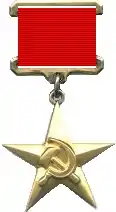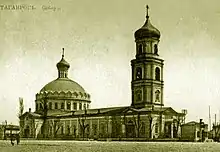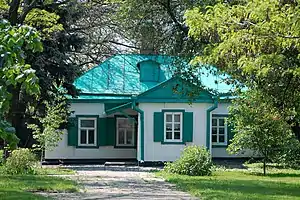Chekhov Gymnasium
The Chekhov Gymnasium in Taganrog on Ulitsa Oktyabrskaya 9 (formerly Gymnasicheskaya Street) is the oldest gymnasium in the South of Russia. Playwright and short-story writer Anton Chekhov spent 11 years in the school, which was later named after him and transformed into a literary museum. Visitors can see Anton's desk and his classroom, the assembly hall and even the punishment cell which he sometimes visited.
Литературный музей им. А.П.Чехова | |
 Chekhov Gymnasium in 2006 | |

| |
| Established | 1809 (as gymnasium) 1975 (as museum) |
|---|---|
| Location | Ulitsa Oktyabrskaya 9, Taganrog |
| Collection size | Expositions related to Anton Chekhov's school years, theater plays by Chekhov (memorabilia, photographs) |
| Director | Yelizaveta Vasilievna Lipovenko Липовенко, Елизавета Васильевна |
| Public transit access | Spartakovsky Station (Street cars: 2,3,5,8,9) |

History of the school
The Boys Gymnasium was founded in 1809 and this building was completed in 1843 by the plans of the Italian architect Francesco Boffo. Students of the Boys Gymnasium benefited from various grants, most of them being introduced by the Greek-Russian merchant and benefactor Ioannis Varvakis (1745–1825). In mid-1870s a school church was made in the same building, and the cross may be seen on some old postcards.
After the Russian Revolution of 1917 and the following Civil War, the building housed a cavalry school (6th Cavalry College), frequently visited by Semyon Budyonny, Klim Voroshilov and Efim Shadenko.
During the Occupation of Taganrog in 1941-1943 used by the Germans as Sicherheitsdienst headquarters.
In 1954, the Boys Gymnasium was named after Anton Chekhov within the framework of events dedicated to the writer's 50th death anniversary memorial year.[1]
In 1975 opened as The Literary Museum named after Anton Chekhov, more commonly known under the short name Chekhov Gymnasium.
January 29, 2010 President of Russian Federation Dmitri Medvedev held a meeting with representatives of the Russian and foreign theatrical communities in Taganrog at the stateroom of the Chekhov Gymnasium literary museum.[2][3]
School years of Anton Chekhov

Anton Chekhov attended a school for Greek boys in Taganrog (1866-1868), and at the age of eight he was sent to the local grammar school (Gymnasium) where he proved an average pupil. Rather reserved and undemonstrative, he nevertheless gained a reputation for satirical comments, for pranks, and for making up humorous nicknames for his teachers. He enjoyed playing in amateur theatricals and often attended performances at the Taganrog Theatre. As an adolescent he tried his hand at writing short "anecdotes," amusing or funny stories, although he is also known to have written a serious long play at this time, "Fatherless," which he later destroyed. He received an annual grant of 300 rubles which had been introduced by the Taganrog City Council after the failed assassination attempt on the tsar Alexander II of Russia.
After the business of Anton Chekhov's father failed, the whole family left for Moscow in 1875-1876. Anton was left in Taganrog to care for himself and finish school. The future world-famous playwright survived selling off household goods and tutoring younger school students at the Boys Gymnasium. In 1879, Chekhov passed his final exams and joined his family in Moscow, where he had obtained scholarship to study medicine at the Moscow University.
The maths rating on Chekhov's school-leaving certificate was signed by Edmund Dzerzhinsky, father of the revolutionary Felix Dzerzhinsky. Dzerzhinsky gave lessons of mathematics in two of Taganrog's gymnasiums - the Girls Gymnasium of Empr. Maria (Мариинская женская гимназия) in 1868-1873 and in the Boys Gymnasium from 1873 until late seventies. Another contemporary instructor was Fyodor Pokrovski (Федор Платонович Покровский), who taught Chekhov theology and gave him the famous nickname Antosha Chekhonte (Антоша Чехонте).
Other famous graduates
- Nikolay Chekhov, artist
- Mikhail Chekhov, writer
- Alexander Chekhov, writer
- Dmitry Girs, writer
 Leonid Gobyato, Russian general, inventor of the first mortar
Leonid Gobyato, Russian general, inventor of the first mortar- Nikolay Sherbina, poet
- Ivan Martos, sculptor
 Alexander Leonidovich Vishnevsky, Russian and Soviet actor
Alexander Leonidovich Vishnevsky, Russian and Soviet actor- Valentin Parnakh, poet, founder of the Soviet Jazz music
- Isaac Yakovlevich Pavlovsky, journalist and writer
- Konstantin Savitsky, artist
- Vladimir Bogoraz, anthropologist and writer
- Samuel Maykapar, composer
- Sergey Dmitrievich Balukhatiy, bibliographer, academic
- Nikolay Apollonovich Belelyubski, scientist, famous designer of bridges
- Alexander Korsun, writer
- Osip Notovich, writer
 Andrei Grechko, Soviet general, Marshal of the Soviet Union (graduate of the Cavalry College)
Andrei Grechko, Soviet general, Marshal of the Soviet Union (graduate of the Cavalry College) Ivan Golubets, the first Hero of the Soviet Union in the Black Sea Fleet
Ivan Golubets, the first Hero of the Soviet Union in the Black Sea Fleet- Zinoviy Vysokovskiy, actor
- Sergey Zvantsev, writer
- Victor Dyomin, Soviet cinema critic, editor, writer
 Kuzma Galitsky, Soviet army general
Kuzma Galitsky, Soviet army general Boris Rivkin, Soviet mayor-general of aviation
Boris Rivkin, Soviet mayor-general of aviation Ivan Kupin, Soviet mayor-general
Ivan Kupin, Soviet mayor-general- Vladimir Dvorkovich international chess arbiter, chairman of the judge board of Russian Federation, father to Arcady Dvorkovich


 Vladimir Grigoryevich Zakharov, Soviet composer, People's Artist of the USSR, art director of Pyatnitsky Choir
Vladimir Grigoryevich Zakharov, Soviet composer, People's Artist of the USSR, art director of Pyatnitsky Choir- Yakov Rubanchik, Soviet architect
Museum
Today the Gymnasium is open to public as The Literary Museum named after Anton Chekhov (Литературный музей А.П.Чехова). After the famous Pushkin House museum in Saint Petersburg, this is the second-largest literary museum in Russia both in terms of space and unique funds. The exhibition includes the library that consists of the antique books of the time and books later sent by Anton Chekhov, his personal belongings, photographs, documents, autographs by Chekhov and other famous people - friends of the writer.
Gallery
Exterior
 The Boys Gymnasium on an old postcard, late 19th century.
The Boys Gymnasium on an old postcard, late 19th century. The Boys Gymnasium on an old postcard, late 19th century.
The Boys Gymnasium on an old postcard, late 19th century..jpg.webp) The Literary Museum Chekhov Gymnasium in 2008.
The Literary Museum Chekhov Gymnasium in 2008. Anton Chekhov statue at the entrance of the gymnasium.
Anton Chekhov statue at the entrance of the gymnasium. The Gymnasium as seen from the Spartakovsky Pereulok, with the Monument Oath of the Youth in front in 2007.
The Gymnasium as seen from the Spartakovsky Pereulok, with the Monument Oath of the Youth in front in 2007.
Inside the museum
 The stateroom at the Gymnasium on Jan.30, 2010 during the Chekhov's 150th birth anniversary celebrations.
The stateroom at the Gymnasium on Jan.30, 2010 during the Chekhov's 150th birth anniversary celebrations. Chekhov's seat in the boys gymnasium. On the left is an original maths test checked by Anton Chekhov's mathematics teacher Edmund Dzerzhinsky.
Chekhov's seat in the boys gymnasium. On the left is an original maths test checked by Anton Chekhov's mathematics teacher Edmund Dzerzhinsky. Punishment cell in the former Taganrog Boys Gymnasium, 2010
Punishment cell in the former Taganrog Boys Gymnasium, 2010 Memorabilia related to Anton Chekhov's The Cherry Orchard play
Memorabilia related to Anton Chekhov's The Cherry Orchard play Memorabilia related to Anton Chekhov's play The Wedding
Memorabilia related to Anton Chekhov's play The Wedding Memorabilia for Chekhov's play Three Sisters
Memorabilia for Chekhov's play Three Sisters
References
- Taganrog Encyclopedia (Энциклопедия Таганрога), 2nd edition, Taganrog, 2003
- История города Таганрога, П.П.Филевский, Москва, 1898
- По старой Греческой, Н.Гаврюшкин, Таганрог, 2003
- «Наш Чехов». «Известия» от 15 июля 1954 г.
- President Medvedev's Opening Remarks at Meeting with Representatives of the Russian and Foreign Theatrical Communities in Taganrog.
- The President of Russian Federation Dmitri Medvedev participated in celebrating the 150th anniversary of the great Russian writer Anton Chekhov in the writer's home city of Taganrog


